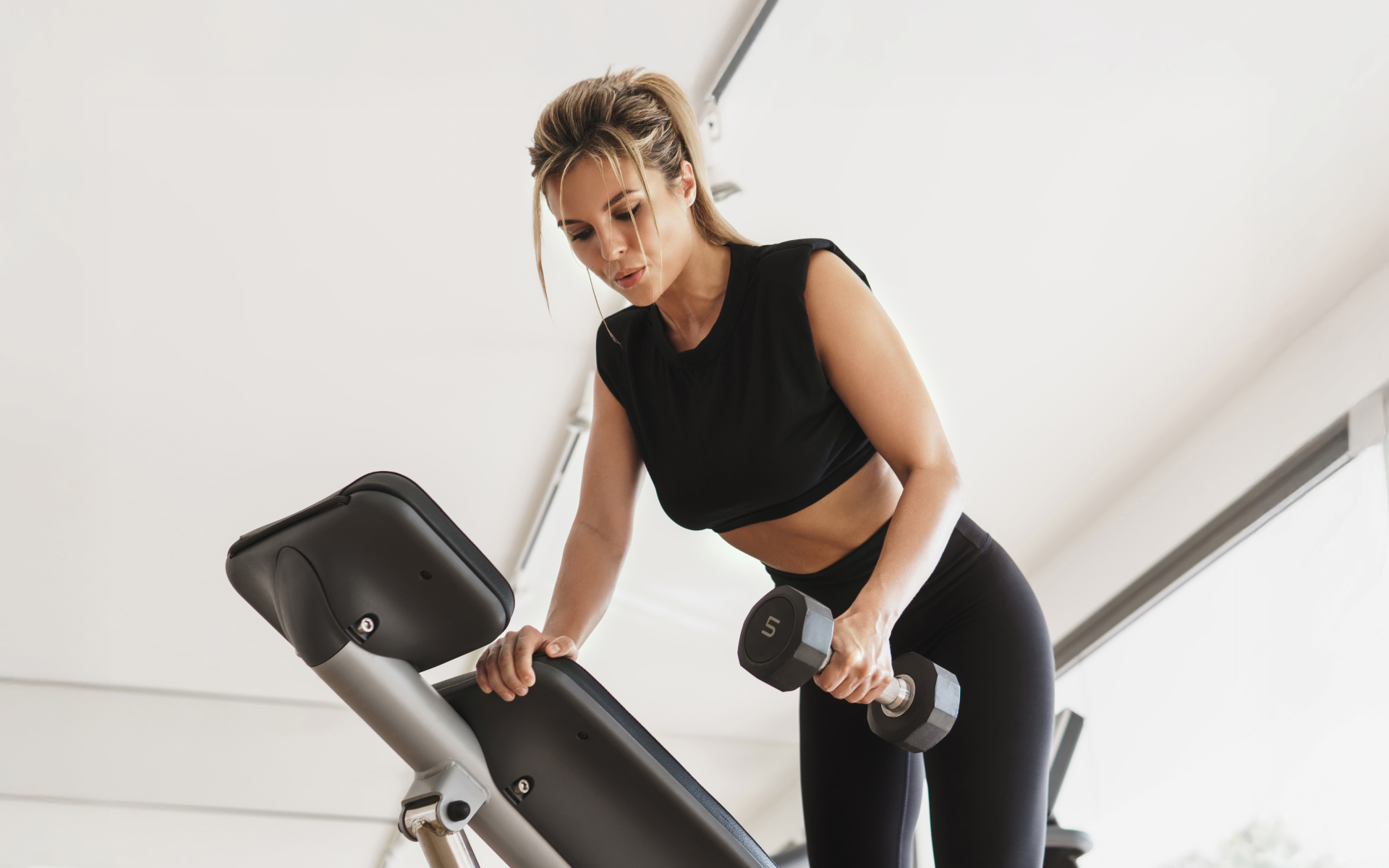How to get rid of a mommy pooch may be one of the first things on your mind, even as you’re bringing your beautiful baby home. Nothing makes you not want to stand in front of the mirror more than the pooch shape behind your belly button. And let’s not even start on the hanging tummy.
Fortunately, you can rid yourself of the mommy pooch and mummy tummy overhang. But let’s have a sneak peek at what to expect. Then, we’ll get to the lifestyle tips and exercises.
Does Mom Pooch Go Away?
Yes, mommy pooch may go away. Here’s a quick look at how:
- Cut refined carbs, refined sugar, trans fat, and processed food (20),
- Reduce your stress (25),
- Lose overall body fat (15),
- Go for brisk walks (17),
- Restrict your calories safely (3),
- Start safe exercises (9).
Looking for a way to break the vicious cycle of weight loss and tone up all the jiggly parts? Watch the extra pounds fly off and your muscles firm up with the BetterMe app!
Is Mommy Pooch Normal?
Knowing how to get rid of a mommy pooch requires knowing why you have one. For one, the Cleveland Clinic has detailed how many women experience postpartum diastasis recti (7). But it isn’t the only cause.
Diastasis Recti and the Mommy Pooch
Diastasis is when the rectus abdominis or six-pack muscles separate in the front to make space for a growing uterus (7). Also, it can occur when the linea alba tissue holding the muscles together overstretches and doesn’t return back together.
Physio-Pedia shows the best abdominal anatomy (2). The rectus abdominis muscles run down the sides of your belly button. The transversus abdominis muscle wraps around your entire waist and attaches to the sides of the six-pack muscles.
The muscles can weaken and stretch while the tissues thin out. The Cleveland Clinic says the linea alba retracts like a rubber band in some women (7). In others, the tissue loses its elasticity and fails to retract the muscles back into place, resulting in the mommy pooch.
The Cleveland Clinic says diastasis recti affects 60% of women postpartum, while 40% still have it after six months (7). Discuss any future workouts or plans with your healthcare provider if you suspect diastasis, as some exercises worsen it, including:
- Boat pose
- Crunches
- Downward dog
- Planks
- Push-ups
Still, Norwegian researchers found that around 67% of women recovered from diastasis after 12 months (8).
Excess Fat and the Mommy Pooch
The muscles and tissue aren’t the only problems with a mommy pooch. Harvard explains how visceral fat is a greater threat than subcutaneous fat (1). The latter is under your skin, but visceral fat collects deep within the abdomen.
The Pennington Biomedical Research Center researchers examined health risks during pregnancy (15). They found that women who carried more visceral fat during the first trimester were at greater risk for higher body fat percentages.
Visceral fat is dangerous and gathers under your rectus abdominus muscles, forcing them to spread and stay apart. Your diet before and during pregnancy may cause a mommy pooch. Your body fat percentage after delivery may cause you to keep a mommy pooch.
The Cleveland Clinic says these foods if consumed in excess can contribute toe more visceral belly fat (20):
- Refined Carbohydrates
- High-fructose corn syrup
- Processed food
- Refined sugar
- Trans fat
Hormones and the Mommy Pooch
Medical News Today shares another possible cause: hormones (11). Hormone imbalances affect the weight you gain around your belly. For example, excess body fat can influences how your body responds to leptin, the hormone that signals fullness cues.
Spanish researchers studied leptin levels during and after pregnancy (12). The study revealed how the placenta and maternal weight gain produce more leptin before birth but drop after delivery. Lower leptin levels may make you hungrier postpartum.
Roman scientists reviewed postpartum hormone changes to understand their effect on PPD (19). Estrogen rapidly declines after delivery while cortisol increases. The Cleveland Clinic says elevated cortisol levels over time may cause weight gain and an increased appetite (25).
Stress may make you crave sugar and carbs that cause visceral belly fat. Meanwhile, Chilean scientists found that declining estradiol may cause weight gain and fail to regulate the metabolism (18). Ultimately, higher body fat percentages may cause a mommy pooch.
Read more: The Best Way to Lose Postpartum Belly Fat and Get Your Pre-Baby Bod Back
What Causes the Mummy Tummy Overhang?
Medical News Today has researched the pannus or apron tummy (14). The things that cause extra lower belly fat also lead to overhang postpartum. After delivery, a sudden drop in belly space causes excess skin and belly fat to hang. The skin may also not be as elastic as before pregnancy.
Mummy Tummy Overhang After C-Section
The Center for Surgery explains how overhang follows a c-section (5). Excess fat during pregnancy, stretched skin, weak muscles, and hormonal changes typically cause overhang after a c-section. However, the apron belly happens after the surgical separation of muscles.
How Do I Get Rid of My Mom Pooch Fast?
Get rid of mommy pooch fast with lifestyle changes and postpartum exercises. Let’s look at the natural ways to rid yourself of the mommy pooch. Also, discuss any changes with your doctor to ensure it’s safe and you don’t have serious diastasis.
Ways to Get Rid of Mommy Pooch Naturally
How to get rid of a mommy pooch naturally is about lifestyle changes.
Losing Body Fat May Get Rid of a Mommy Pooch
Pennington’s research shows mommy pooch and visceral fat are best friends (15). Targeting belly fat just isn’t possible. So, you must lose body fat. Mayo Clinic researchers found visceral fat to be associated with possible metabolic complications (16). More body weight is associated with more belly fat, which can pose adversities to health.
Dropping your overall body fat percentage may reduce belly fat deposits. Harvard suggests using aerobic exercises to reduce visceral body fat (17). The CDC recommends 30 minutes daily with two days rest if you use moderate-intensity aerobics, like brisk walking (21).
Switching to Low-Calorie Meals May Reduce the Mommy Pooch
The Mayo Clinic suggests eating more calories than you burn daily may cause excess belly fat (4). Consuming a nutritious diet can help burn visceral belly fat. However, be careful while breastfeeding. North Carolina nutritionists examined the safe calorie intake versus calories burned during lactation (3).
Ensuring energy intake meets your individual requirements while doing 45 minutes of aerobic exercises four days weekly is one method that can help. Besides, did you know breastfeeding burns calories? The Guardian states how breastfeeding in the first two months may burn up to 595 calories daily (24). Hence, you must ensure adequate calorie intake for optimal health.
The Mayo Clinic suggests low-calorie foods with high fiber and healthy fat sources (22):
- Air-popped popcorn
- Dried fruits
- Fruit (blueberries, mangoes, and peaches)
- Lean protein (egg white, fish, lentils, peas, poultry, and low-fat dairy)
- Healthy fats (monounsaturated and polyunsaturated fat in flaxseed, olive, and nut oil)
- Vegetables (asparagus, broccoli, carrots, tomatoes, and zucchini)
- Whole grains (brown rice, whole grain cereal, and wholewheat pasta)
Eating Healthier Foods May Get Rid of Mommy Pooch
The right foods help you lose body fat, which helps to reduce your belly fat. WebMD suggests adding high-antioxidant and high-fiber foods to your daily intake may burn body fat (10). These foods may burn fat, curb cravings, and kickstart the metabolism:
- Black unsweetened coffee
- Capsaicin (jalapenos and habaneros)
- Cinnamon
- Eggs
- Fruit (apples, berries, grapefruit, grapes, and pears)
- Garbanzo beans
- Green tea
- Lean protein (chicken, turkey, etc.)
- Nuts (almonds,
- Oatmeal
- Omega-3-rich fish (salmon, tuna, mackerel, etc.)
- Quinoa
- Raw vegetables
- Tabouli
A Belly Band May Reduce a Mommy Pooch
The NHS confirms how elasticized abdominal support may help the linea alba retract to bring the muscles back together (9). Use a belly band in the first weeks postpartum. It may even improve your postpartum posture, caused by slouching and excess sitting while breastfeeding or holding a newborn.
Workout to Get Rid of Mommy Pooch
Exercises to eliminate the mommy pooch are possible. Still, remember to speak to your doctor if you have diastasis to ensure you don’t do harmful workouts. Let’s see which exercises to use if you have diastasis or must avoid bulging your abdomen during workouts.
Postpartum Workout for a Mommy Pooch (Before 3 Weeks)
The NHS recommends two exercises within the first six weeks postpartum if you have the okay from your doctor (9). This workout includes five exercises to help strengthen the rectus and transversus or core muscles after birth.
Pelvic Floor Exercise
- Sit with your legs crossed and back straight on a flat, supportive surface,
- Squeeze your pelvic muscles, and hold for 10 seconds,
- Repeat the exercise 10 times thrice daily.
Transversus Abdominis Exercise
- Sit upright on a flat, supportive surface,
- Breathe in slowly as you contract your abdominal muscles,
- Hold them for 5-10 seconds and release them,
- Repeat it 5-10 times thrice daily.
Diaphragmatic Breathing
Benchmark Physical Therapy confirms diaphragmatic breathing is safe to regain control over the transversus abdominus muscles (13).
- Sit upright before inhaling deep into your core,
- Fill your abdomen with air before squeezing the abs to release it,
- Your shoulders must remain still as you repeat it ten times twice daily.
Posterior Pelvic Tilts
Pelvic floor exercises safely enhance diaphragmatic breathing to activate core muscles (13).
- Bend your knees and keep your feet flat as you lie on your back,
- Press your lower back into the floor by sucking in your belly button,
- Don’t hold your breath as you hold this position for 5-8 seconds,
- Release your belly before doing it five more times twice daily.
Brisk Walking
The research advises a 45-minute brisk walk, but the CDC also says 30 minutes five days weekly isOKe (3, 21). Put your baby in a stroller, and walk briskly to end your daily workout.
Postpartum Mommy Pooch Workout 2 (After 3 Weeks)
Please discuss this workout with your doctor, especially with severe diastasis (7). However, these exercises don’t extend the abdomen to worsen the separation. You can start them three weeks postpartum, even adding them to earlier movements.
Banded Hip Abductions
Hip abductions are safe to strengthen the transversus and rectus abdominis muscles (13).
- Lie flat with a resistance band around your legs, just below your bent knees,
- Engage your abs as you do a posterior pelvic tilt and hold for 5-8 seconds,
- Spread your knees within the band and hold for 3-5 seconds,
- Return to the relaxed position and repeat 5-8 times twice daily.
Modified Side Plank
Side Lying positions don’t bulge your stomach muscles and activate the core (13).
- Support yourself on your elbow as you prop onto your side,
- Bring the lower bent knee under the straight upper leg,
- Tighten your core as you press weight onto your straight leg’s foot to plank,
- Hold the position for 3-5 seconds and repeat three times daily.
Clamshells
Clamshells are another muscle endurance builder to activate the core muscles (13).
- Get into a modified plank with both knees bent and lying to your side,
- Keep your heels together as you rotate the top knee toward the ceiling,
- Tighten your core while repeating 5-8 clamshells twice daily.
Supine Ball Squeezes
Benchmark Physical Therapy found supine exercises activate the core muscles (13).
- Lie flat with bent knees and feet flat against the floor,
- Place a ball between your inner thighs,
- Tilt your pelvis posteriorly while tightening your core,
- Squeeze the ball and hold for 3-5 seconds,
- Release and return to the starting position,
- Repeat 5-8 times twice daily.
Standing March
Various marches are good for activating and building endurance in the core muscles (13).
- Stand upright and place your hands criss-crossed behind your head,
- Tighten your core before lifting one leg and inhaling deeply,
- Your knee should align as comfortably with your hips as possible,
- Lower the leg as you exhale, changing to the other leg,
- Repeat ten marches on each leg.
If you tend to let yourself off the hook, raise the white flag when things get tougher than you expected, send yourself on an unconscious binge-eating trip – BetterMe app is here to help you leave all of these sabotaging habits in the past!
Can I Get Rid of Mommy Tummy Overhang?
Get rid of mommy tummy with exercises and changes that break down overall body fat. You must continue eating the right foods, losing body fat, and eating nutrient-dense foods (10, 17, 22). Continue maintaining a tcalorie intake suitable for your requirements, especially if you’re still breastfeeding (3).
Alternatively, lower your calories to 1500 daily if you aren’t breastfeeding. The Mayo Clinic says dropping daily calorie intake by 500 helps you lose ½-1 pounds weekly (6). Then, speak to a doctor about exercising after the diastasis closes.
You can safely use the exercises not recommended during diastasis once the linea alba retracts the rectus transversus and transversus abdominis muscles together (7). You’ll tone those muscles with simple exercises to tighten the mommy tummy overhang.
Exercises to Get Rid of Mommy Tummy Overhang
Exercises to get rid of mommy tummy overhang are only good if you have no diastasis (7). Benchmark Physical Therapy suggests using strength exercises from week seven and impact workouts from week eight (13). First, get a doctor’s permission!
Step-Ups
- Stand in front of a step or bench,
- Move one foot onto the platform before raising the other,
- Move back down in the same rhythm,
- Complete 8-10 reps daily.
Box Squats
- Stand in front of a chair,
- Raise one knee in front of you until it’s nearly parallel to the floor,
- Stop if you feel uncomfortable,
- Sit back into the chair while keeping that leg extended,
- Stand back up and repeat five times before switching legs.
Mountain Climbers
- Get into a push-up position with bent knees,
- Start climbing the mountain by bringing your knee toward your core,
- Tighten your core during this climb, and release as your leg goes back,
- Repeat each leg 5-8 times daily.
Reverse Crunches
Crunches aren’t great in the weeks postpartum, but reverse crunches are fine after seven weeks (13).
- Lie flat, and reach overhead to grab a support beam,
- Raise your knees into your chest to make a hollow body position,
- Breathe in deeply as the knees rise, and exhale as they drop,
- Repeat 5-8 times daily.
Downward Dog Knee Tuck
- Enter a downward-facing dog position,
- Raise the right leg to move into a down-dog split,
- Go as high as comfortably possible before gently swinging the knee toward your chest,
- Switch legs and repeat, completing 5-8 reps on each side.
Read more: 8 Drinks to Burn Belly Fat The Healthy Way
FAQs
Can You Get Rid of An Apron Belly With Exercise?
Yes, you may reduce an apron belly with exercise. However, the Benchmark Physical Therapy study shows that exercises to tone the lower abdomen are better seven weeks postpartum (13). However, speak to your doctor if you have severe diastasis recti (7).
Does Walking Reduce Hanging Belly?
Yes, brisk walking can help reduce visceral belly fat, according to Harvard (17). Brisk walking is possible postpartum and counts as moderate-intensity exercise. The CDC recommends walking 30 minutes daily with two rest days or 150 minutes weekly (21).
How Long Does It Take to Get Rid of Hanging Belly?
It may take six weeks to a year. WebMD explains how the uterus returns to its pre-pregnancy weight and size six weeks after birth (23). Some women are fortunate to lose weight within this period due to safe exercises and lifestyle changes.
Unfortunately, some women take up to a year to lose the hanging belly, especially if they don’t follow the recommendations. For example, reduce calorie intake to create a deficit, do aerobic exercises, and eat healthier foods to ensure you lose the hanging belly faster (3, 17, 10).
The Bottom Line
How to get rid of a mommy pooch or apron belly is no longer a mystery. However, please follow the safety guidelines, especially while breastfeeding or if you have severe diastasis. Otherwise, choose the recommended workout by your postpartum stage.
DISCLAIMER:
This article is intended for general informational purposes only and does not serve to address individual circumstances. It is not a substitute for professional advice or help and should not be relied on for making any kind of decision-making. Any action taken as a direct or indirect result of the information in this article is entirely at your own risk and is your sole responsibility.
BetterMe, its content staff, and its medical advisors accept no responsibility for inaccuracies, errors, misstatements, inconsistencies, or omissions and specifically disclaim any liability, loss or risk, personal, professional or otherwise, which may be incurred as a consequence, directly or indirectly, of the use and/or application of any content.
You should always seek the advice of your physician or other qualified health provider with any questions you may have regarding a medical condition or your specific situation. Never disregard professional medical advice or delay seeking it because of BetterMe content. If you suspect or think you may have a medical emergency, call your doctor.
SOURCES:
- Abdominal Fat, and What to Do About It – Harvard Health (2019, health.harvard.edu)
- Abdominal Muscles – Physiopedia (n.d., physio-pedia.com)
- Balancing Exercise and Food Intake With Lactation to Promote Post-Partum Weight Loss (2011, pubmed.ncbi.nlm.nih.gov)
- Belly Fat in Women: Taking – and Keeping – It Off (2023, mayoclinic.org)
- Belly Overhang After C-Section | Center for Surgery (n.d., centerforsurgery.com)
- Counting Calories: Get Back to Weight Loss Basics (2023, mayoclinic.org)
- Diastasis Recti (Abdominal Separation: Symptoms and Treatment (2022, my.clevelandclinic.org)
- Diastasis Recti Abdominis During Pregnancy and 12 Months After Childbirth: Prevalence, Risk Factors and Report of Lumbopelvic Pain (2016, ncbi.nlm.nih.gov)
- Divarication of Abdominal Muscles | North Bristol NHS Trust (n.d., nbt.nhs.uk)
- Fat-Burning Foods: Blueberries, Green Tea, and More (2022, webmd.com)
- Hormonal Belly: Causes and Treatment (2023, medicalnewstoday.com)
- Leptin Action in Normal and Pathological Pregnancies (2018, ncbi.nlm.nih.gov)
- Maximizing Recovery in the Postpartum Period: A Timeline for Rehabilitation from Pregnancy through Return to Sport (2022, ncbi.nlm.nih.gov)
- Pannus Stomach: Causes, and How to Reduce It (2023, medicalnewstoday.com)
- Pregnancy as a Window to Future Health: Excessive Gestational Weight Gain and Obesity (2016, ncbi.nlm.nih.gov)
- Role of Body Fat Distribution and the Metabolic Complications of Obesity (2008, ncbi.nlm.nih.gov)
- Taking Aim at Belly Fat – Harvard Health Publishing (2021, health.harvard.edu)
- The Importance of Estradiol for Body Weight Regulation in Women (2022, ncbi.nlm.nih.gov)
- The Neuroendocrinological Aspects of Pregnancy and Postpartum Depression (2019, ncbi.nlm.nih.gov)
- Visceral Fat: What It Is, and How to Get Rid of It (2022, my.clevelandclinic.org)
- Walking | Physical Activity | CDC (2022, cdc.gov)
- Weight Loss: Feel Full on Fewer Calories (2023, mayoclinic.org)
- When Does Postpartum Belly Go Away? (2023, webmd.com)
- Why the Truth About Breastfeeding and Weight Loss is Far From the Myth (n.d., theguardian.com)
- You Guessed It: Long-Term Stress Can Make You Gain Weight (2023, health.clevelandclinic.org)









